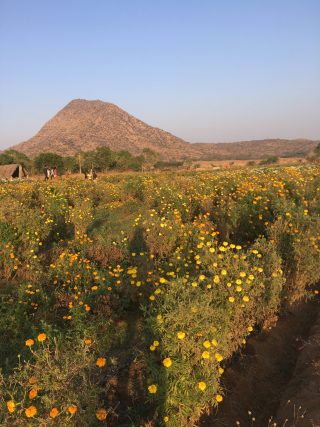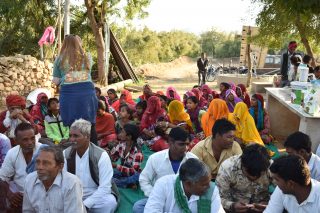The day started early in New Delhi as we prepared for our bus ride to Ajmer. The whole trip took roughly five hours. When we arrived in Ajmer, we met our hosts next to a gate off the side of the road and they led us through the tiny, curvy dirt roads of Nadi Village.
From the bus we could see vast fields of yellow, white, and orange and could smell the flowers sweet aroma, a welcomed contrast from the tightly packed city of New Delhi.
After about 10 minutes of amazing maneuvering by our bus driver through the village, we came to a stop in the road slightly past an intersection. Through the large windows we could see men, women, and children gathering around the bus and excitedly waiting for us to step off. After shuffling to gather our things and some chocolates we had bagged to hand out to the children, we began to file off of the bus. As soon as the first person stepped onto the sandy Nadi Village soil, a parade began. Two young men beat on drums hanging by their sides from around their necks as the villagers showered us with the delicate, beautiful, intensely colored petals of marigolds and chrysanthemums from their fields. There wasn’t a single person in our presence that didn’t radiate joy, happiness, and celebration.
Occasionally you could feel the thump of an entire flower and look back to find the person who threw it at you; it was more than likely the adolescent attempting to stifle a mischievous grin, surrounded by their friends who were giggling uncontrollably.
After we had walked for a few minutes, we were signaled to come to a stop where we then formed a haphazard semicircle around one of our hosts, Dr. Ravindra Singh, a principal scientist at the National Research Centre on Seed Spices (NRCSS). The drumming and throwing of flower petals continued, however, and Dr. Singh explained to us that this was a typical welcome for guests and that it was being done in our honor. The villagers began to freely dance in the circle to the beat, or not, of the drums, and the elders swept rupees (money) over the heads of each person in the semi circle before stuffing it into the shirt pockets of the boys beating on the drums.
After observing this joyous and fascinating experience for several minutes, a petite woman displaying a wide, beautiful smile and dressed in a bright yellow saree motioned me with some English to make my way to seats that had been set out just for the guests, and were placed so that we would be face to face with the villagers. Stationed a few yards away were large solar panels used to supply energy throughout the agricultural processes in the village.
A mat of green turf had been rolled out for everyone else to sit on. When the villagers went to sit they arranged themselves by gender. The males occupied the front of the turf while the females occupied the space behind them.
Some of the women had their faces covered with the stunning, colorful fabrics we had started to become familiar with. This, we later learned, signified that these women were in the presence of their mother in law and is a quickly fading custom in more urban areas of India, but in rural and remote areas such as Nadi Village, the custom is still practiced.
Once everyone was adjusted, young women were asked to place beautiful handmade leis comprised of flowers harvested from their own fields around all of our necks, one by one.
Following this small ceremonial gesture, Dr. Singh began to explain to us that NRCSS has been working with the people of Nadi Village on implementing multiple sustainable farming practices with the hope that the farmers are able to increase their outputs while decreasing the inputs necessary such as irrigation water, fertilizers and pesticides.
The farmers rely largely on composting from recycled materials to deliver much of the nutrients needed to the plants and soil. Of the supplemental fertilizers and pesticides the farmers do have to use, all of them are organic, Dr. Singh tells us. This decreases the damage done to the ecosystems around the area and is better for the soil, as well as for the farmers and laborers working with the products as they are frequently at risk of being poisoned by the more harmful synthetic products.
To reduce the amount of wasted irrigation water in the fields, drip irrigation lines were used throughout them. The drip irrigation lines looked like hoses with small holes equidistant from each other and were
onto the soil next to the plant roots. This increases the efficiency of water that reaches the plants root systems by decreasing the amount of evaporation seen in the relatively common sprinkler irrigation systems. 
Other practices used by the farmers include rotating their fields every year to few years, and something similar to agroforestry where they sow smaller plant varieties under the canopies of orchards. This increases the use efficiency and productivity of the land in many different ways, and also works to provide more crops that the farmers can sell or use themselves.
After Dr. Singh gave us this brief but informative overview, we passed out chocolate candies to the children and others, and we were taken on a tour around a few of the fields. As we were guided through the fields, people were taking pictures of us, asking for selfies, and even sneaking videos and pictures of all of the students.
When we all had our share of pictures and information from the fields we started back towards the bus, as the sun was about to set. Along the way we were able to star in a few more photographs and were handed gooseberries from the trees to enjoy on our short walk.
From looking at the fields and from the proud looks on the villager’s faces, it was obvious these practices have been working well for them. I think there is a lot to be said for their success, and I think this is a fantastic example for farmers in the United States to look to and learn from when contemplating their own agricultural practices.
Our group is extremely grateful to our hosts and the people of Nadi Village who were the essence of open and inviting. The short time we had in the village was a wonderful learning experience and the interactions and connections we made were priceless.

